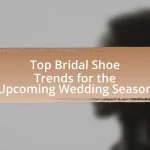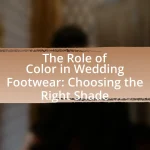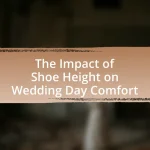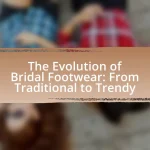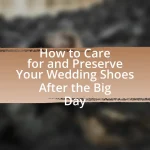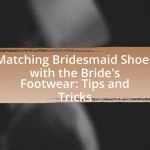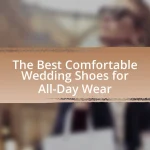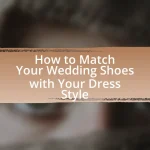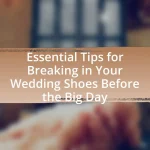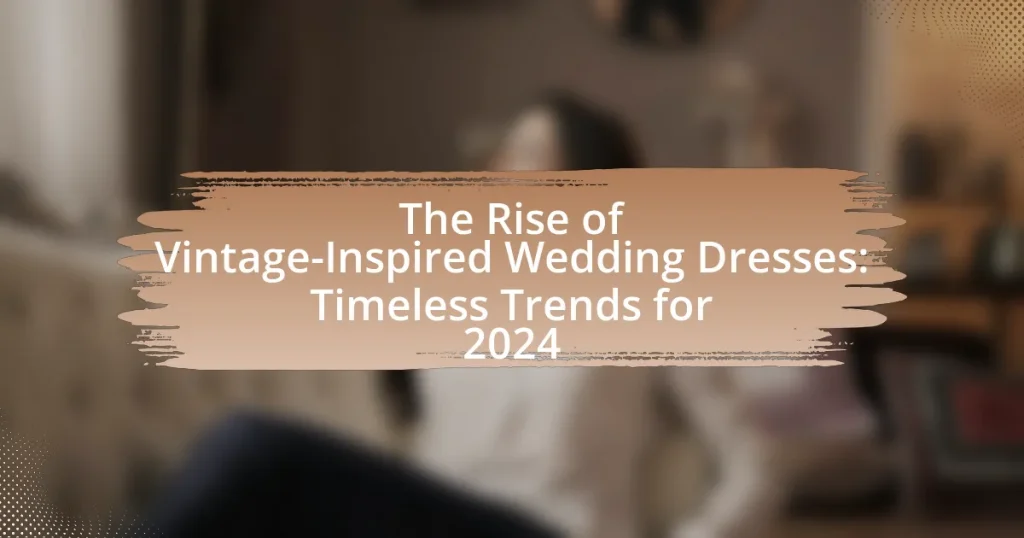Vintage-inspired wedding dresses are bridal gowns that incorporate design elements from past fashion eras, particularly from the 1920s to the 1970s. These dresses are characterized by features such as lace, intricate beadwork, and unique silhouettes, appealing to brides seeking nostalgia and individuality. The article explores the differences between vintage-inspired and modern designs, the historical influences on these styles, and the growing popularity of vintage aesthetics in 2024, driven by cultural factors, social media, and sustainability. Key trends for the year include the resurgence of 1920s flapper styles and 1970s bohemian elements, along with guidance on selecting and accessorizing vintage-inspired dresses to create a cohesive wedding look.
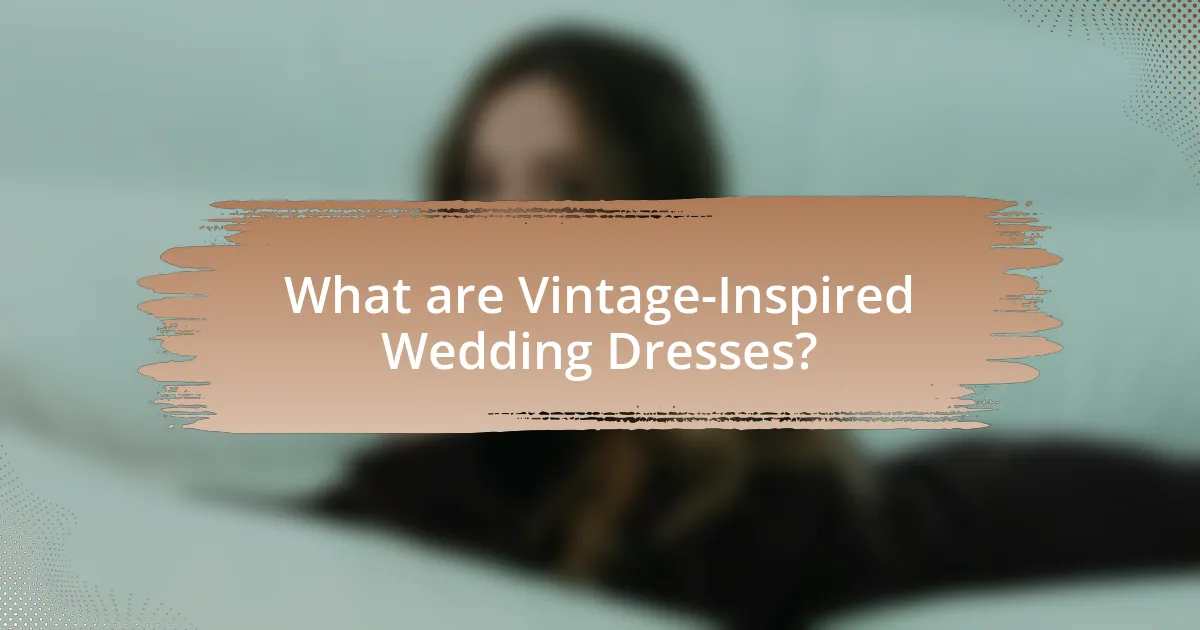
What are Vintage-Inspired Wedding Dresses?
Vintage-inspired wedding dresses are bridal gowns that draw design elements from past fashion eras, typically ranging from the 1920s to the 1970s. These dresses often feature characteristics such as lace, intricate beadwork, and unique silhouettes that reflect the styles of their respective decades. For example, a 1920s vintage-inspired dress may include a dropped waist and flapper-style embellishments, while a 1950s design might showcase a full skirt and fitted bodice. The popularity of these dresses is supported by a growing trend among brides seeking to incorporate nostalgia and individuality into their wedding attire, as evidenced by the increasing number of designers specializing in vintage styles and the rise of vintage-themed weddings.
How do vintage-inspired wedding dresses differ from modern designs?
Vintage-inspired wedding dresses differ from modern designs primarily in their silhouette, fabric choices, and detailing. Vintage-inspired dresses often feature classic silhouettes such as A-line or ball gown shapes, which were popular in past decades, while modern designs may incorporate more contemporary cuts like sheath or mermaid styles. Additionally, vintage dresses typically utilize fabrics like lace, tulle, and satin, emphasizing intricate embellishments and hand-sewn details, whereas modern designs may favor minimalist aesthetics and synthetic materials. Historical trends, such as the use of tea-length skirts in the 1950s or the bohemian styles of the 1970s, further distinguish vintage-inspired dresses from the streamlined, often simpler lines of contemporary wedding attire.
What historical styles influence vintage-inspired wedding dresses?
Vintage-inspired wedding dresses are primarily influenced by historical styles from the Victorian era, the Roaring Twenties, and the 1950s. The Victorian era introduced intricate lace, high necklines, and voluminous skirts, which are often echoed in modern designs. The Roaring Twenties brought about flapper styles characterized by dropped waistlines and beading, influencing many contemporary vintage looks. The 1950s are known for their classic silhouettes, such as A-line dresses and fitted bodices, which continue to inspire current bridal fashion. These historical styles provide a rich foundation for the aesthetic and design elements found in vintage-inspired wedding dresses today.
How do fabric choices impact the vintage aesthetic?
Fabric choices significantly impact the vintage aesthetic by influencing the texture, drape, and overall appearance of garments. For instance, fabrics like lace, silk, and taffeta evoke historical styles and craftsmanship associated with specific eras, such as the Victorian or Edwardian periods. The use of these materials can enhance the authenticity of vintage-inspired wedding dresses, as they reflect the quality and detail characteristic of past fashions. Additionally, the weight and flow of fabrics contribute to the silhouette and movement of the dress, further aligning it with vintage styles. Historical references indicate that lace was a popular choice in the 1920s for its delicate and romantic qualities, making it a staple in modern vintage designs.
Why are vintage-inspired wedding dresses gaining popularity in 2024?
Vintage-inspired wedding dresses are gaining popularity in 2024 due to a growing desire for nostalgia and individuality among brides. This trend reflects a shift towards unique, personalized wedding experiences, as many couples seek to differentiate their celebrations from traditional norms. The resurgence of vintage aesthetics is supported by fashion influencers and social media platforms showcasing retro styles, which resonate with younger generations. Additionally, the sustainability movement encourages the use of vintage and upcycled materials, appealing to environmentally conscious consumers. This combination of nostalgia, individuality, and sustainability solidifies the appeal of vintage-inspired wedding dresses in 2024.
What cultural factors contribute to the rise of vintage trends?
Cultural factors contributing to the rise of vintage trends include nostalgia, sustainability, and the influence of social media. Nostalgia drives consumers to seek items that evoke memories of past eras, often associated with perceived authenticity and quality. The sustainability movement encourages individuals to choose vintage items as eco-friendly alternatives to fast fashion, reducing waste and promoting recycling. Additionally, social media platforms amplify vintage aesthetics, allowing influencers and users to showcase vintage styles, thereby increasing their popularity and accessibility. These interconnected cultural elements create a fertile ground for the resurgence of vintage trends in various markets, including fashion and wedding attire.
How do social media and celebrity influence play a role?
Social media and celebrity influence significantly shape fashion trends, including the rise of vintage-inspired wedding dresses. Celebrities often showcase their wedding attire on platforms like Instagram and Pinterest, creating a visual impact that inspires brides-to-be. For instance, when a high-profile celebrity wears a vintage-style gown, it can lead to a surge in interest and demand for similar designs, as evidenced by a 2021 study from the Journal of Fashion Marketing and Management, which found that celebrity endorsements can increase consumer purchasing intentions by up to 30%. This dynamic interaction between social media visibility and celebrity choices drives trends and influences the bridal market, making vintage styles more appealing to modern brides.
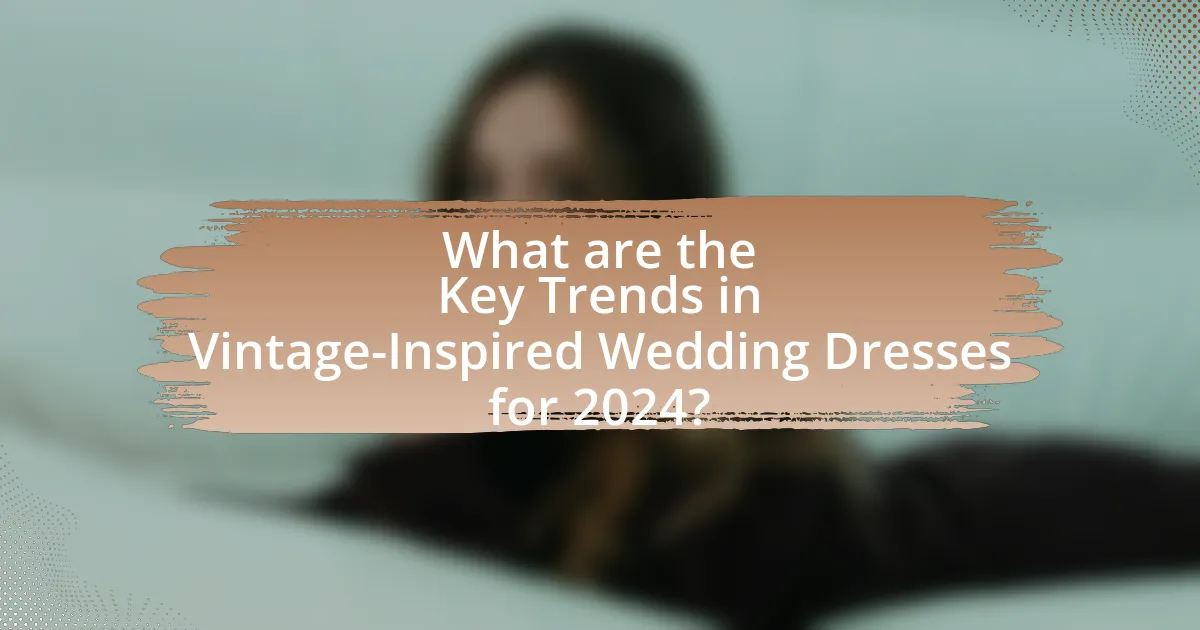
What are the Key Trends in Vintage-Inspired Wedding Dresses for 2024?
Key trends in vintage-inspired wedding dresses for 2024 include the resurgence of 1920s flapper styles, 1970s bohemian elements, and the incorporation of sustainable fabrics. The 1920s influence is characterized by intricate beadwork and dropped waist silhouettes, appealing to brides seeking glamour and elegance. The 1970s bohemian trend emphasizes flowing fabrics, lace details, and relaxed fits, catering to a more casual and free-spirited aesthetic. Additionally, the focus on sustainability is driving designers to use eco-friendly materials, aligning with the growing demand for environmentally conscious fashion choices in the wedding industry.
Which specific vintage styles are trending this year?
The specific vintage styles trending this year include 1920s Art Deco, 1970s bohemian, and 1990s minimalist designs. The 1920s Art Deco style is characterized by intricate beadwork and geometric patterns, reflecting the glamour of the Jazz Age. The 1970s bohemian style features flowing fabrics and earthy tones, appealing to those seeking a relaxed, free-spirited aesthetic. The 1990s minimalist designs emphasize clean lines and simplicity, resonating with modern brides who prefer understated elegance. These trends are supported by fashion industry reports indicating a resurgence of interest in vintage aesthetics, particularly in bridal wear.
What elements define the 1920s flapper style in wedding dresses?
The elements that define the 1920s flapper style in wedding dresses include dropped waistlines, straight silhouettes, and intricate embellishments. Flapper wedding dresses often feature a loose fit that allows for ease of movement, reflecting the liberated spirit of the era. Additionally, materials such as silk and chiffon were commonly used, often adorned with beading, fringe, or lace to enhance the visual appeal. The flapper style also embraced bold colors and patterns, moving away from the traditional white, which was a significant shift in bridal fashion during that time. This style is rooted in the cultural changes of the 1920s, where women sought to express their independence and modernity through fashion.
How does the 1970s bohemian style manifest in modern designs?
The 1970s bohemian style manifests in modern designs through the incorporation of flowing silhouettes, earthy color palettes, and eclectic patterns. Designers today often draw inspiration from the free-spirited aesthetic of the 1970s, utilizing lightweight fabrics like chiffon and lace to create romantic, ethereal wedding dresses. This era’s emphasis on individuality is reflected in modern designs that feature unique embellishments, such as fringe and embroidery, which echo the handcrafted, artisanal vibe of the past. Additionally, the resurgence of vintage-inspired elements, such as bell sleeves and maxi lengths, highlights the enduring appeal of bohemian style in contemporary fashion.
What colors and fabrics are popular for vintage-inspired dresses in 2024?
In 2024, popular colors for vintage-inspired dresses include soft pastels like blush pink, mint green, and lavender, alongside rich jewel tones such as emerald and burgundy. Fabrics favored for these dresses are lightweight materials like chiffon and lace, as well as heavier options like velvet and silk, which enhance the vintage aesthetic. This trend reflects a resurgence of classic styles, as seen in fashion shows and collections that emphasize nostalgia and timeless elegance.
How do lace and tulle contribute to the vintage look?
Lace and tulle significantly enhance the vintage look by adding intricate textures and ethereal qualities to garments. Lace, with its delicate patterns and historical associations dating back to the 15th century, evokes a sense of nostalgia and elegance that is quintessential to vintage aesthetics. Tulle, a lightweight and airy fabric, complements lace by providing volume and softness, reminiscent of styles popular in the early to mid-20th century. Together, these materials create a layered effect that is characteristic of vintage wedding dresses, appealing to modern brides seeking timeless designs.
What color palettes are emerging for vintage wedding dresses?
Emerging color palettes for vintage wedding dresses in 2024 include soft pastels, muted earth tones, and rich jewel tones. Soft pastels like blush pink, lavender, and mint green evoke a romantic, nostalgic feel, while muted earth tones such as sage green, terracotta, and dusty blue provide a modern yet vintage aesthetic. Rich jewel tones, including emerald green, deep burgundy, and sapphire blue, add a luxurious touch reminiscent of classic vintage styles. These palettes reflect a blend of timeless elegance and contemporary trends, appealing to brides seeking a unique yet traditional look for their wedding day.
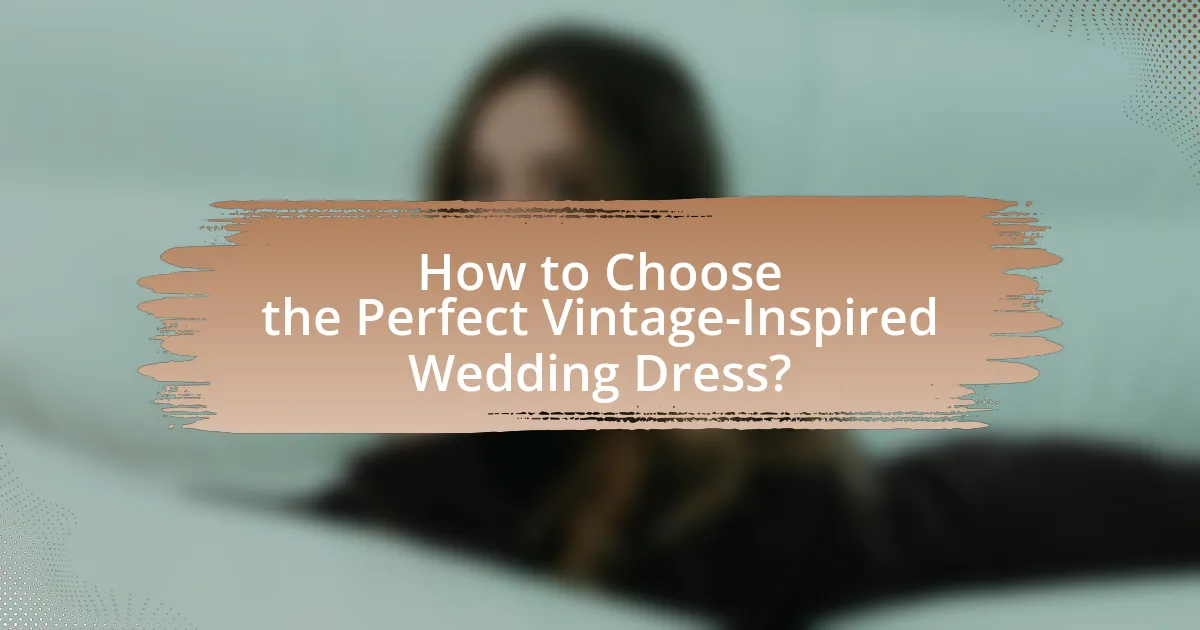
How to Choose the Perfect Vintage-Inspired Wedding Dress?
To choose the perfect vintage-inspired wedding dress, focus on identifying the specific vintage era that resonates with your style, such as the 1920s flapper or the 1950s tea-length silhouette. Each era has distinct characteristics, like fabric choices and design elements, which can guide your selection. For instance, the 1920s often feature intricate beadwork and drop waists, while the 1950s emphasize full skirts and fitted bodices. Understanding these details helps narrow down options that align with your vision. Additionally, consider the dress’s fit and comfort, as well as how well it complements your wedding theme and venue. This approach ensures that the chosen dress not only reflects vintage aesthetics but also suits your personal style and the overall wedding ambiance.
What factors should brides consider when selecting a vintage-inspired dress?
Brides should consider the era of the vintage-inspired dress, as different decades offer distinct styles, fabrics, and silhouettes. For example, the 1920s are known for flapper dresses with beading, while the 1950s feature fuller skirts and fitted bodices. Additionally, brides should evaluate the dress’s fit and comfort, ensuring it complements their body shape and allows for ease of movement throughout the day. Fabric choice is also crucial; materials like lace, silk, and tulle can enhance the vintage aesthetic. Lastly, brides should consider the overall theme of their wedding, as the dress should harmonize with the venue and decor to create a cohesive look.
How does body shape influence the choice of vintage dress style?
Body shape significantly influences the choice of vintage dress style by determining which silhouettes and cuts enhance an individual’s figure. For instance, hourglass shapes often favor styles that accentuate the waist, such as 1950s fit-and-flare dresses, while pear-shaped bodies may opt for A-line dresses that balance proportions. Additionally, those with a rectangular shape might choose vintage styles with ruffles or embellishments to create the illusion of curves. Historical fashion trends, such as the 1920s flapper dresses, cater to straight body types, emphasizing a more boyish silhouette. Thus, understanding body shape allows individuals to select vintage dresses that not only fit well but also flatter their unique proportions.
What role does the wedding theme play in dress selection?
The wedding theme significantly influences dress selection by dictating the style, color palette, and overall aesthetic of the attire. For instance, a vintage-themed wedding typically calls for dresses that reflect historical styles, such as lace details or tea-length silhouettes, aligning with the nostalgic elements of the theme. This alignment ensures that the bride’s dress complements the venue, decor, and overall ambiance, creating a cohesive visual experience. Additionally, specific themes may inspire choices in fabric and embellishments, reinforcing the desired atmosphere of the celebration.
What are some tips for accessorizing vintage-inspired wedding dresses?
To accessorize vintage-inspired wedding dresses effectively, choose pieces that complement the dress’s era and style. For example, if the dress is from the 1920s, opt for art deco jewelry, such as a statement headpiece or drop earrings, which enhance the vintage aesthetic. Additionally, consider incorporating lace gloves or a vintage clutch to add elegance and authenticity. Fabrics like silk or satin for accessories can also harmonize with the dress’s material, ensuring a cohesive look. Finally, select shoes that reflect the vintage style, such as Mary Janes or classic pumps, to complete the ensemble.
How can jewelry enhance the vintage aesthetic?
Jewelry enhances the vintage aesthetic by incorporating designs, materials, and craftsmanship that reflect historical styles. Vintage jewelry often features intricate details, such as filigree work, gemstones set in unique patterns, and materials like pearls and antique gold, which evoke a sense of nostalgia. For example, Art Deco jewelry, characterized by geometric shapes and bold colors, complements vintage-inspired wedding dresses by adding a touch of elegance and authenticity. The use of such jewelry not only accentuates the overall look but also connects the wearer to the fashion trends of past eras, reinforcing the timeless appeal of vintage aesthetics.
What types of veils or headpieces complement vintage dresses?
Veils and headpieces that complement vintage dresses include birdcage veils, lace veils, and floral crowns. Birdcage veils, often made of netting, evoke a 1920s aesthetic and pair well with flapper-style dresses. Lace veils, which feature intricate patterns, enhance the romantic and classic look of vintage gowns, particularly those inspired by the Victorian or Edwardian eras. Floral crowns, made from fresh or faux flowers, add a bohemian touch that aligns with vintage styles from the 1960s and 1970s. These accessories not only enhance the overall vintage theme but also reflect historical fashion trends, making them suitable choices for modern brides seeking a timeless look.
What are the best practices for finding and fitting vintage-inspired wedding dresses?
The best practices for finding and fitting vintage-inspired wedding dresses include researching specific vintage styles, visiting specialized boutiques, and ensuring proper measurements for an accurate fit. Researching styles such as 1920s flapper or 1950s tea-length dresses helps narrow down options that align with personal aesthetics. Visiting boutiques that focus on vintage or vintage-inspired designs increases the likelihood of finding authentic pieces or high-quality reproductions. Taking accurate measurements, including bust, waist, and hip sizes, is crucial for fitting, as vintage sizing often differs from modern standards. Additionally, considering alterations by a skilled tailor can enhance the fit and overall appearance of the dress, ensuring it complements the bride’s figure and style.
